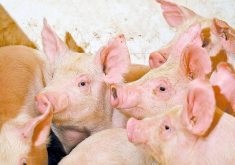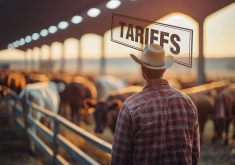It’s estimated there are close to 1,000 wild horses, generally found in herds of 15 to 20 animals, roaming a territory that ranges from Kananaskis Country, west of Bragg Creek, to Hinton and Edson.
“I’ve had people approach my office for the preservation of wild horses and then I’ve had some trappers complain that these horses have been problematic,” said Joe Anglin, MLA for Rimbey/Rocky Mountain House/Sundre.
“Some people argue that they’re feral horses, but these horses have been out there a couple of generations, so they are truly wild.”
Read Also

Horns aren’t unlocking anytime soon on livestock transport standards
Standards good enough meet the definition of “humane” animal transportation still vary widely between what what industry wants, what animal rights advocates want and, between the two, what federal regulators decide is good enough.
They’ve actually been around for much longer than that, said Bob Henderson, president of the Wild Horses of Alberta Society (WHOAS), a 550-member group set up in 2001 to monitor and study wild horses, as well as to educate the public and lobby government for their protection.
“As early as 1805, David Thompson documented that there were horses roaming free in that country,” said Henderson, a lifelong horse enthusiast who lives in Olds. “They’ve been there a lot longer than the government wants us to believe.”
Henderson, who gives presentations at schools and to 4-H and other groups, argues the existence of wild horses should be celebrated.
“We should be recognizing them for the part they have played in our history,” he said, adding early settlers would catch and use wild horses on their homesteads.
Members of his group have rescued young wild horses who have been injured or abandoned, and even purchased horses from trappers to save them from slaughter. Henderson and his group gentle the younger horses and arrange to have them adopted. He noted there are now several outfits that take tourists to see the herds.
But the horses also cause problems, said Carrie Sancartier, a public affairs officer with Alberta Environment and Sustainable Resource Development, which has responsibility for the animals.
“They are considered a concern because they compete for food with deer and elk,” said Sancartier. “They also compete with livestock by foraging and they can impact rangeland health and tree regeneration.”
There’s enough forage for all, countered Henderson.
“One only has to roam through that area there and spend some time out there and see that there is so much grass and forage there’s enough for everything out there,” he said.
Horses also pose a traffic risk, particularly on the Sunchild Road in Brazeau County northwest of Rocky Mountain House.
“This poses a danger to vehicles travelling, so that’s a huge issue,” said Anglin.
Still, no one is arguing for the destruction of the wild horses, he said, although that has happened as recently as 2011 when 220 horses were captured, most of which were sent for slaughter.
But since then the government has stopped issuing Horse Capture Licences, and is reviewing how to best manage the wild herds.
Before giving any thought to another cull, research is needed on topics such as the animals’ range and habitat and what are manageable herd sizes in order to develop a proper, science-based management strategy, said Anglin.
Part of that strategy should include capturing younger animals, gentling them, and putting them up for adoption, said Henderson.
“There are a lot of people who appreciate these horses and what they can do,” he said.















